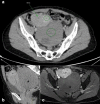CT review of ovarian fibrothecoma
- PMID: 35451310
- PMCID: PMC10162058
- DOI: 10.1259/bjr.20210790
CT review of ovarian fibrothecoma
Abstract
Objective: The aim of this study was to investigate the CT imaging characteristics of ovarian fibrothecoma which may aid in the differentiation from early stage epithelial tumours.
Methods: Comparison of 36 patients (41 lesions) with pathologically proven ovarian fibrothecoma tumours and 36 (52 lesions) serous papillary carcinomas (SPCs) lesions. We noted their laterality, size, density, calcifications, Hounsfield units (HUs) and introduced a novel HU comparison technique with the psoas muscle or the uterus. Patients' clinical findings such as ascites, pleural effusion, carbohydrate antigen-125 levels, and lymphadenopathy findings were also included.
Results: Average age was 67.8 and 66 across the fibrothecoma and SPC cohort respectively. Fibrothecoma tumours had diameters ranging from 24 to 207 mm (Median: 94 mm). 80.6% of the fibrothecoma cohort had ascites which was comparable to the 72.2% in the SPC cohort. 70.7% of fibrothecoma tumour favour a purely to predominantly solid structural configuration (p < 0.001). The average HU value for the fibrothecoma solid component was 44 ± 11.7 contrasting the SPC HU value of 66.8 ± 15. The psoas:tumour mass ratio demonstrated a median of 0.7, whereas SPCs shows a median of 1.1 (p < 0.001).
Conclusion: Suspicion of ovarian fibrothecoma should be considered through interrogation of their structural density configuration, low psoas to mass HU ratio and a presence of ascites.
Advances in knowledge: CT imaging can be a useful tool in diagnosing fibrothecoma tumours and subsequently reducing oncogynaecological tertiary centre referrals, financial burden and patient operative morbidity and mortality.
Figures











Similar articles
-
CT diagnosis in the thecoma-fibroma group of the ovarian stromal tumors.Cell Biochem Biophys. 2015 Mar;71(2):937-43. doi: 10.1007/s12013-014-0288-7. Cell Biochem Biophys. 2015. PMID: 25315640
-
Ovarian fibroma/fibrothecoma: retrospective cohort study shows limited value of risk of malignancy index score.Aust N Z J Obstet Gynaecol. 2013 Jun;53(3):287-92. doi: 10.1111/ajo.12090. Epub 2013 Apr 23. Aust N Z J Obstet Gynaecol. 2013. PMID: 23611791
-
Ovarian fibroma/fibrothecoma with elevated serum CA125 level: A cohort of 66 cases.Medicine (Baltimore). 2018 Aug;97(34):e11926. doi: 10.1097/MD.0000000000011926. Medicine (Baltimore). 2018. PMID: 30142807 Free PMC article.
-
[Demons-Meigs syndrome: information on a new case and review of the literature].Rev Pneumol Clin. 2011 Apr;67(2):121-3. doi: 10.1016/j.pneumo.2010.10.002. Epub 2011 Mar 21. Rev Pneumol Clin. 2011. PMID: 21497729 Review. French.
-
Ovarian mass, pleural effusion, and ascites: revisiting Meigs syndrome.J Bronchology Interv Pulmonol. 2013 Jan;20(1):48-51. doi: 10.1097/LBR.0b013e31827ccb35. J Bronchology Interv Pulmonol. 2013. PMID: 23328144 Review.
Cited by
-
A typical case of ovarian fibrothecoma in a paucisymptomatic postmenopausal woman.Radiol Case Rep. 2025 May 2;20(7):3501-3504. doi: 10.1016/j.radcr.2025.03.086. eCollection 2025 Jul. Radiol Case Rep. 2025. PMID: 40417323 Free PMC article.
-
Comprehensive analysis of calcification frequency and patterns in ovarian tumours using non-contrast CT.Jpn J Radiol. 2025 Jul;43(7):1153-1165. doi: 10.1007/s11604-025-01750-4. Epub 2025 Mar 5. Jpn J Radiol. 2025. PMID: 40038215 Free PMC article.
-
Ovarian fibrothecoma in a 15-year-old girl: A rare case report.Radiol Case Rep. 2025 May 5;20(7):3550-3554. doi: 10.1016/j.radcr.2025.04.011. eCollection 2025 Jul. Radiol Case Rep. 2025. PMID: 40453541 Free PMC article.
-
A Rare Occurrence of a Huge Ovarian Thecoma in a Menopausal Patient, 25 Years After Abdominal Hysterectomy and Right Salpingo-Oophorectomy: A Case Report and Mini-Review of the Literature.Cureus. 2024 Nov 7;16(11):e73258. doi: 10.7759/cureus.73258. eCollection 2024 Nov. Cureus. 2024. PMID: 39651023 Free PMC article.
-
Fibrothecoma of the Ovary; Clinical and Imaging Characteristics.Womens Health Rep (New Rochelle). 2025 Mar 25;6(1):315-324. doi: 10.1089/whr.2024.0153. eCollection 2025. Womens Health Rep (New Rochelle). 2025. PMID: 40308368 Free PMC article.
References
-
- Kurman RJ RJ, Carcangiu ML ML, Herrington C. Classification of tumours of the ovary. 4th ed. WHO Classification of Tumours; 2014, pp.44–56.
MeSH terms
Substances
Supplementary concepts
LinkOut - more resources
Full Text Sources
Medical

